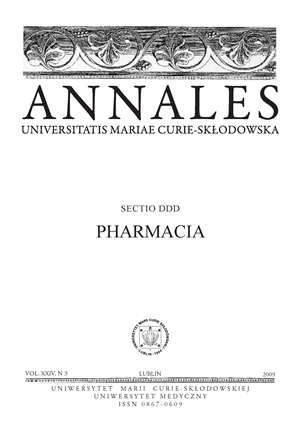Wpływ jednorazowego podania diazepamu i nowego anksjolitycznego preparatu Selankna spontaniczne zachowanie się królików
Abstrakt
Celem badania było porównanie wpływu pochodnej benzodwuazepiny – diazepamu i syntetycznego analogu tuftsyny – Selank na sześć rodzajów spontanicznego zachowania się królików. Eksperymenty były wykonywane w dwu grupach zwierząt. W pierwszej grupie podawano dożylnie diazepam w dawce 1 mg/kg, w drugiej grupie podawano donosowo Selank w dawce 200 μg/kg. Każde doświadczenie trwało 2h. Diazepam redukował reakcje orientacyjno-poznawcze i pobieranie pokarmu, wydłużał fazę komfortu. Analog tuftsyny nie zmieniał czasu trwania badanych faz.
Bibliografia
1. Ashmarin I. P., Samonina G. E., Lyapina L. A. et al.: Natural and hybrid (“chimeric”) stable regulatory glyproline peptides. Pathophysiology, 11, 179, 2005.
2. Ber t B., Fink H., Sohr R., Rex A.: Different effects of diazepam in Fischer rats and two stocks of Wistar rats in tests of anxiety. Pharmacol. Biochem. Behav., 70, 411, 2001.
3. Bulatova N. R., Romanova E. A., Krinskaya A. V. et al.: Poststressor correction of the functional macrophage activity by tuftsin and its derivatives. (Russian) Biull. Eksp. Biol. Med., 108, 64, 1989.
4. Burke F. T., Miller L. G., Moerschbaecher J. M.: Acute effects of benzodiazepines on operant behavior and in vivo receptor binding in mice. Pharmacol. Biochem. Behav., 1994, 48(1), 69-76.
5. Clement Y., Chapouthier G.: Biological bases of anxiety. Neurosci. Biobehav. Rev., 22(5), 623, 1998.
6. Cooper S. J.: Palatability-dependent appetite and benzodiazepines: new directions from the
1. pharmacology of GABA A receptor subtypes. Appetite, 44(2), 133, 2005.
7. Czabak-Garbacz R., Cygan B., Wolański Ł., Kozlovsky I. I.: Influence of long-term treatment with tuftsin analogue TP-7 on the anxiety-phobic states and body weight. Pharmacol. Rep., 58, 562, 2006.
8. Houston A. J., Wong J. C. L., Ebenezer I. S.: Effects of subcutaneous administration of the gamma-aminobutyric acid A receptor agonist muscimol on water intake in water-deprived rats. Physiol. Behav., 77, 445, 2002.
9. Jing X., Wala E. P., Sloan J. W.: The effect of PK 11195, a specific antagonist of the peripheral benzodiazepine receptors, on body weight in rats chronically exposed to diazepam. Pharmacol. Res., 42(3), 227, 2000.
10. Kalueff A. V., Tuohima a P.: Mouse grooming microstructure is a reliable anxiety marker bidirectionally sensitive to GABAergic drugs. Eur. J. Pharmacol., 508, 147, 2005.
11. Kozlovskaya M. M., Kozlovski I. I., Val’dman E. A., Seredenin S. B.: Selank and short peptides of the tuftsin family in the regulation of adaptive behaviour in stress. Neurosci. Behav. Physiol., 33, 853, 2003.
12. Kozlovski I. I., Danchev N. D.: The optimizing action of the synthetic peptide Selank on a conditioned active avoidance reflex in rats. Neurosci. Behav. Physiol., 33, 639, 2003.
13. Lang O., Mezö G., Hudecz F., Köhidai L.: Effect of tuftsin and oligotuftsins on chemotaxis and chemotactic selection in Tetrahymena pyriformis. Cell. Biol. Int., 30, 603, 2006.
14. Neznamov G. G., Telashova E. S., Bochkarev V. K., Koschelev V. V.: Novel anxiolytic Selank: Results of the phase II clinical trials. Eur. Neuropsychopharmacol., 15, suppl 2, 159, 2005.
15. Rex A., Stephens D. N., Fink H.: “Anxiolytic” action of diazepam and abecranil in a modified open field test. Pharmacol. Biochem. Behav., 53(4), 1005, 1996.
16. Scot t S. J, Smith P. F., Darlington C. L.: Quantification of the depressive effects of diazepam on the guinea pig righting reflex. Pharmacol. Biochem. Behav., 47(3), 739, 1994.
17. Semenova G. P., Gurevich E. V., Kozolvskaya M. M., Gromova E. A.: The role of the brain monoaminergic systems in the effects of tuftsin and its analogue on animal emotional behaviour. (Russian) Fiziol. Zh. SSSR. Im I. M. Sechenova, 75, 759, 1989.
18. Semenova T. P., Kozlovskaya M. M., Zuikov A. V. et al.: Seasonal effects of Selank on the behaviour of hibernating animals. (Russian) Biull. Eksp. Biol. Med., 140, 658, 2005.
19. Seredenin S. B., Blednov Y. A., Kozlovski I. I.: Studies of the anti-anxiety action of an analog of the endogenous peptide tuftsin in inbred mice with different phenotypes for emotional stress reactions. Zh. Vyssh. Nerv. Deyat., 48(1), 153, 1998.
20. Söderpalm A. H. V., Berridge K. C.: Food intake after diazepam, morphine or muscimol: microinjections in the nucleus accumbens shell. Pharmacol. Biochem. Behav., 66(2), 429, 2000.
21. Stout J. C., Weiss J. M.: An animal model for measuring behavioral responses to anxiogenic and anxiolytic manipulations. Pharmacol. Biochem. Behav., 47(3), 459, 1994.
22. Tallmann J. F., Paul S. M., Skolnick P. P., Gallager D. W.: Receptors for the age of anxiety: pharmacology of the benzodiazepines. Science, 207, 274, 1980.
Pobrania
Opublikowane
Numer
Dział
Licencja
Prawa autorskie (c) 2011 Autorzy

Praca jest udostępniana na licencji Creative Commons Attribution-NonCommercial-NoDerivatives 3.0 Unported License.


